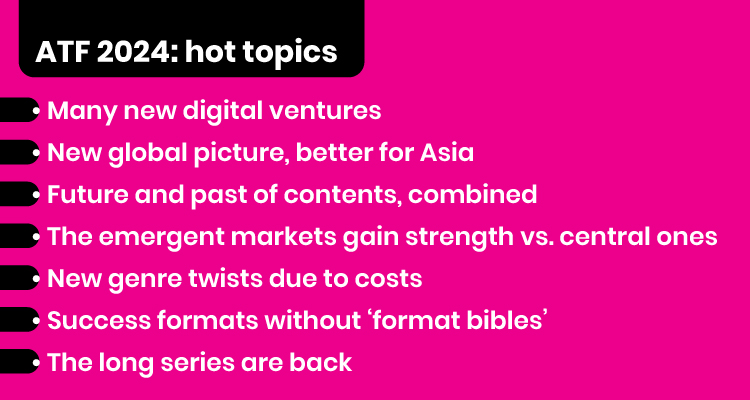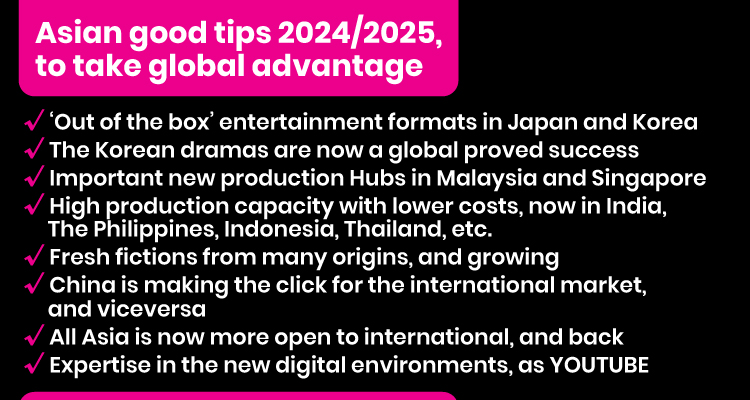This new edition of the Asia TV Forum (ATF) in Singapore promises to be very engaging. On one hand, there is a significant increase in new digital ventures, with the rise of AVOD, FAST, CTV and live-streaming platforms entering the market. On the other hand, content market trends continue to surprise each quarter. What it was seen at Mipcom a month and a half ago in Cannes, France, offers an auspicious outlook for Asian companies globally, if they make well-informed decisions.

What happened at Mipcom? There were two main takeaways: first, while the industry is moving forward with digital advancements, there is a surprising return to traditional formulas, creating a sort of ‘Back to the Future’ dynamic that requires a constant shift between past and future. Second, central markets are experiencing a downturn, while emerging markets are gaining momentum. This shift has particularly benefited Asian players—especially Japan and Korea— as well as regions like CEE, MENA and Latin America.
In one of our daily reports from Mipcom, we questioned whether a “bizarre market” is being created, with weird trends. Let’s examine these two main takeaways and explore where opportunities are for Asia, and particularly for APAC, including distribution, production, services, broadcasting and platforms.
A dual temporal face

The future-past dynamic is essentially two interconnected processes: first, a progressive and rapid evolution toward digital, with social media, on-demand, live streaming and now artificial intelligence (AI) as cornerstones. In the second process, there’s a return to traditional basics to secure business stability: procedurals, the resurgence of free-to-air TV, a shift back to advertising versus subscriptions, and a return to major international distribution over OTT exclusivity.
Moreover, entertainment formats are seeing guaranteed success making remakes of the big classics, and at these times of budget constraints, old successful series are frequently chosen because they don’t need promotion to be watched. The returns to advertising and international distribution have profoundly reshaped the business, almost as if we were back in previous times. This is why now is needed to shift between past and future, intending to achieve a “timeless” approach that can serve both ends of the spectrum.
The Rise of Emerging Markets

Today, the four most prominent content-producing countries are in crisis, experiencing project cuts, rising costs, and layoffs. The United States is grappling with the writers’ strike, which has halted many projects; the United Kingdom is facing the repercussions of Brexit and inflation; France and Germany are encountering social issues, with Germany even facing economic challenges for the first time in a long while. How are leading companies addressing this? By expanding into emerging markets in search of financial support or fresh energy.
Since the pandemic, most studios, format giants and platforms in the United States and Western Europe have been facing a systematic recession and reduction. In contrast, companies from emerging nations have mastered creating fresh content with fewer resources, lower costs, and smaller teams. Central markets, which once looked down on them, now have to learn from and follow their ‘lead’.
The “bizarre” market and its weird trends
This interplay between future-past dynamics and central-emerging power shifts is disrupting many long-held industry norms. In Europe, for instance, some fiction projects are turning into docu-fictions, with up to 60% real sequences to reduce costs. Consider also the Japanese format ‘LOL: Last One Laughing,’ which has achieved unique global success despite lacking a “bible” due to its simplicity and adaptability. Yoshimoto Kyogo and Prime Video have already made 20 adaptations of the format worldwide.
The rise of emerging markets is also changing series length. Recently, shorter series were on the rise, but now, the emerging world, representing two-thirds of the global market, prefers longer horizontal (daily) series over weekly episodic vertical formats. This shift benefits Turkish, Korean and Latin American distributors with long series (40 episodes and up), while UK and French distributors of shorter series sell less. Longer series better amortize per-episode costs, drawing in audiences with engaging narratives.
Asian players: repositioning together
Asia encompasses several distinct markets. Japan and South Korea resemble European markets, standing out in “out-of-the-box” entertainment formats. Korea has also become a leader in dramas, enjoying widespread success globally and currently undergoing further expansion. India, once known as a Bollywood powerhouse, is experiencing a production boom with higher quality standards, while countries like Indonesia, the Philippines and Thailand are showing production strength but still seek recognition for meeting production standards.
Malaysia and Singapore, the host of ATF, have become significant production hubs for the region, working with global partners. They now serve as entry and exit points for the Asian business scene. China, the giant, is gradually expanding its international ties. Both Chinese companies and global giants are learning how to operate effectively together. It’s a challenging endeavor, but progress is underway.
The good news is that Asian products have significantly evolved, with less reason to envy central markets. There are impressive developments in both fiction and entertainment across a wide variety of genres, allowing Asian content to enter even very demanding markets. The surge in Korean dramas is the most notable example, but international markets are now more open to Asian products, with many more doors open than before.
This new situation offers greater flexibility and potential for Asian companies. Naturally, the crisis in central markets won’t last forever, and they remain the leaders. However, these are times of increased alliances, greater potential at each commercial link, and opportunities to produce faster and more cost-effectively. Making wise decisions now means accessing more markets, focusing on quality while others scale back, and identifying opportunities through collaboration with partners.
All of these can start to take shape at this ATF edition, where many foreign companies come to do business with Asia and APAC. This is a time for mutually beneficial discussions, receiving while also proposing, and exploring new business spaces. The world is different now, more welcoming and flexible for those without pedigree. Management is key now. Let’s move forward…
Nicolás Smirnoff







